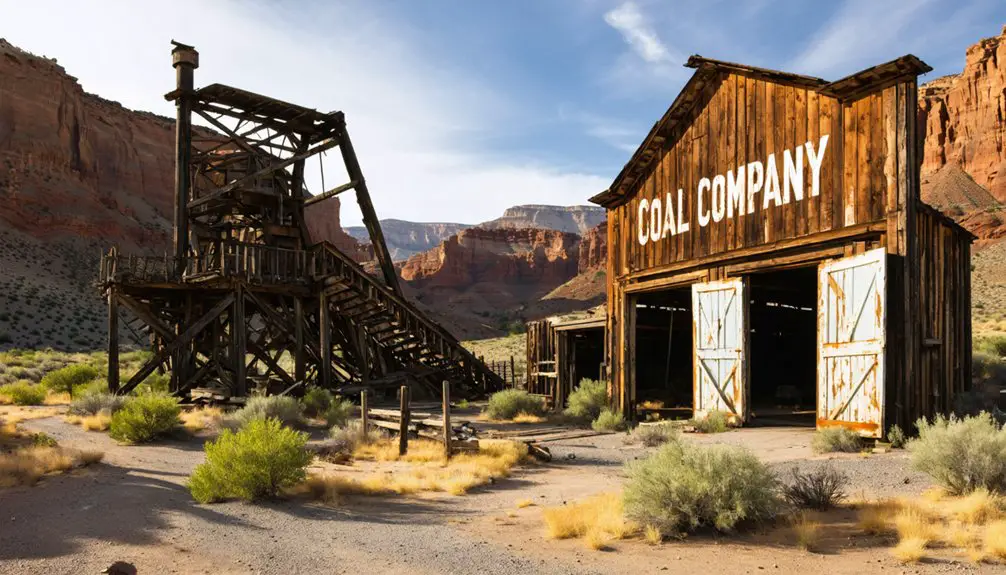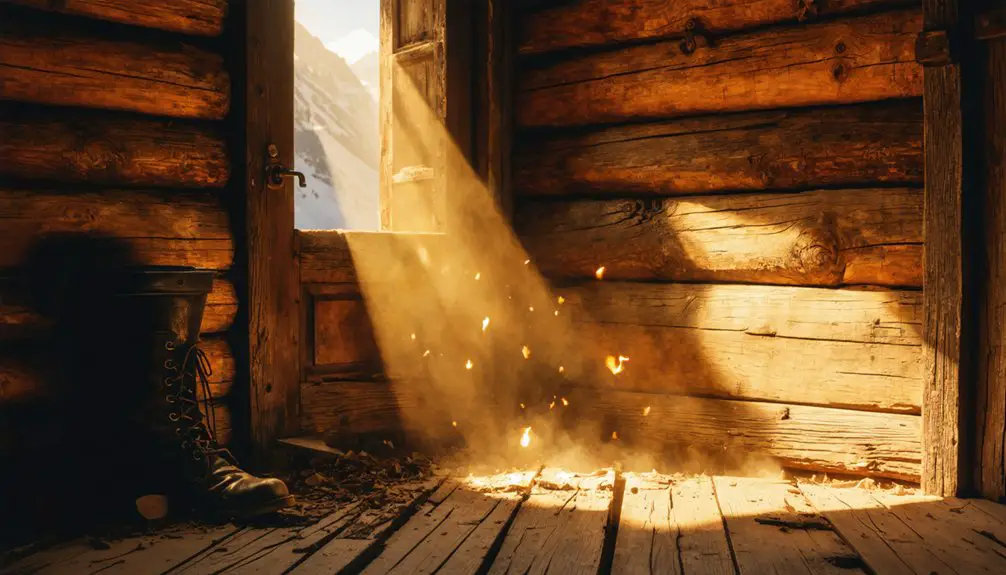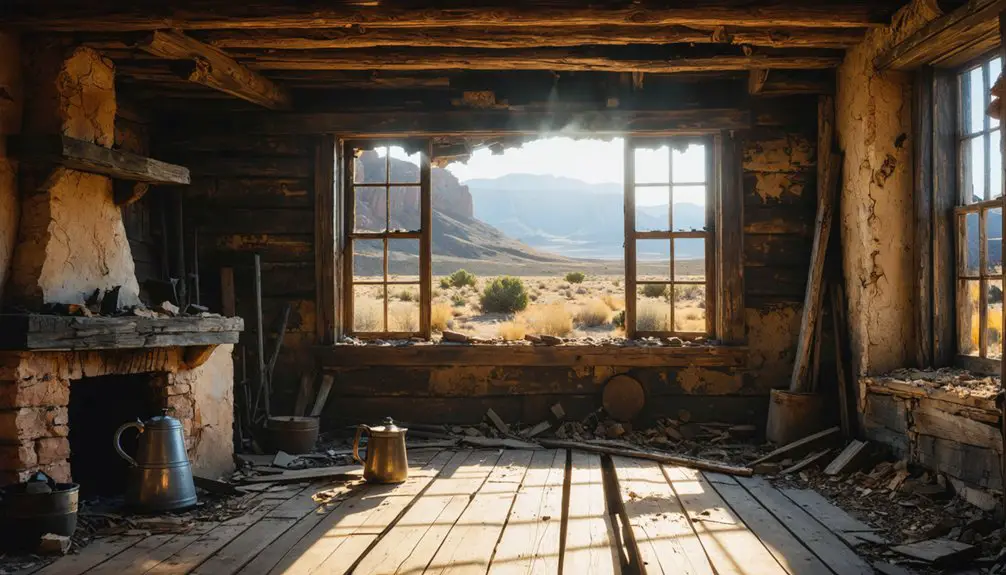You’ll find Mill Fork tucked away in Utah’s American Fork Canyon, where it emerged as a bustling railroad town in 1872. At its peak, 250 residents worked the three sawmills, railroad operations, and charcoal manufacturing facilities. The town’s decline began after an 1893 scarlet fever epidemic devastated the community, followed by economic hardships when steam engines gave way to diesel. Today, the Mill Fork Cemetery’s 46 graves silently preserve the town’s poignant history.
Key Takeaways
- Mill Fork was established in 1872 as a railroad boomtown in Utah, reaching its peak with 250 residents and three sawmills.
- The town’s economy centered around timber production, railroad operations, and charcoal manufacturing for the Rio Grande Railroad.
- A devastating scarlet fever epidemic in 1893 significantly impacted the community, causing numerous child deaths and altering the town’s future.
- Mill Fork declined after 1890 due to the closure of its charcoal business, general store, and reduced railroad activity.
- The town’s cemetery contains 17 marked graves and up to 46 possible burials, serving as a preserved reminder of Mill Fork’s history.
The Birth of a Railroad Boomtown
The promise of mineral wealth spurred the American Fork Railroad‘s creation in 1872, giving birth to Mill Fork as a bustling railroad boomtown. New York businessmen, operating through Miller Mining and Smelting Company, launched this ambitious narrow gauge railroad project to connect American Fork with Forest City across 16 miles of challenging terrain.
You’ll find the story of rapid development in Mill Fork’s early days, as railroad construction began that spring with rails and equipment arriving by July. Under the management of Major Edmund Wilkes, the railroad’s development set new standards for the territory’s transportation infrastructure.
Within months, test operations commenced on August 20, and by November 26, the line reached its terminus at Deer Creek. Like the Utah Coal Railway established decades later in 1912, the railroad’s development was driven by the need to transport valuable mining resources.
The railroad’s presence transformed Mill Fork into a hub of economic activity, drawing workers and businesses seeking to capitalize on the region’s mining operations and newfound transportation access.
Life in Mill Fork’s Industrial Heyday
During Mill Fork’s industrial peak, you’d find a tight-knit community of around 250 residents whose lives revolved around the demanding work of three sawmills and railroad operations.
Industrial workers spent their days logging timber, operating heavy machinery, and hauling 100-pound grain sacks, while massive flume systems transported logs efficiently through the region. Workers began incorporating more efficient circle saw operations, replacing older methods. Much like the ice harvesters of other Utah towns, workers endured harsh conditions to make their living.
The community dynamics centered around company-provided housing and the local general store, where workers and their families gathered for supplies and social interaction.
But life wasn’t without its challenges – a devastating scarlet fever epidemic in 1893 hit the town hard, particularly affecting children.
With minimal health infrastructure, the community relied on informal quarantine measures. The town’s cemetery, with its numerous child graves, stands as a memorial to these difficult times.
A Self-Sustaining Community
Mill Fork’s economic importance relied on the seamless integration of farming and industry, with railroad workers and sawmill employees often maintaining their own vegetable gardens and livestock.
You’ll find evidence of this self-sufficiency in the way residents constructed and supplied their own general store while managing multiple sawmills that provided both employment and building materials.
The community’s strategic location along Spanish Fork Canyon allowed farmers to cultivate crops on the river flats while accessing mountain resources, creating a balanced economy that supported the town’s peak population of 250 inhabitants.
The tragic deaths of three Finch children to scarlet fever in 1893 highlighted the challenges faced by this otherwise prosperous frontier community.
The town’s industrial activities were further diversified by the presence of three charcoal kilns that processed local Pinion Pine wood into valuable charcoal products.
Local Economy Thrived
While many ghost towns faded quickly, Mill Fork established itself as a thriving, self-sustaining community built on the backbone of three major industries: timber production, railroad operations, and charcoal manufacturing.
You’d find three bustling sawmills in the canyon, processing Spruce and Pine into railroad ties for the Rio Grande Railroad. The town’s economic engine ran on more than just timber production – it boasted a general store and four section houses supporting railroad workers, plus a large water tank and reservoir system built in 1888. At its height, the town supported a peak population of 250 residents. Similar to modern platforms that make your day, the town provided numerous entertainment and social activities for its residents.
Local manufacturing thrived as teams with wagons harvested Pinion Pine for the charcoal kilns, creating a crucial fuel source for regional industry. The interconnected nature of these operations created jobs for generations of residents, from logging to retail, making Mill Fork a model of economic independence in pioneer-era Utah.
Farms Supported Residents
Beyond the industrial backbone of Mill Fork, a network of farms along the river corridor formed the foundation of the community’s self-sustaining character. You’d find farms strategically placed on every available flat spot, where residents practiced soil conservation through careful crop rotation of potatoes, hay, and grain.
The farms weren’t just about sustenance; they were the anchors of community life. You could see how the agricultural rhythm integrated with other activities – from charcoal production to railroad work.
While farmers maximized their limited arable land, they produced enough to support about 250 residents at the town’s peak. Despite harsh mountain conditions, these farms reduced Mill Fork’s reliance on outside supplies, though ultimately, the constraints of terrain and climate would challenge the town’s long-term survival.
The Cemetery’s Silent Stories
You’ll find that Mill Fork Cemetery’s most tragic tales stem from an 1893 scarlet fever outbreak that claimed the lives of three young Finch sisters, aged 3 to 5, who were among the first to be buried there.
The cemetery’s western section holds numerous unmarked graves, their stories remaining untold until 2005 when research efforts helped identify some of the forgotten souls. The chicken wire fence surrounds these weathered monuments, preserving their historical significance.
Young lives were disproportionately represented in the cemetery’s records, with childhood diseases, accidents, and limited medical care reflecting the harsh realities of frontier life in this remote Utah settlement.
The well-maintained grounds today stand as a testament to the community’s dedication to preserving this historically significant site.
Scarlet Fever’s Fatal Impact
Although Mill Fork’s remote location initially seemed to shield it from disease outbreaks, a devastating scarlet fever epidemic struck the small Utah railroad town in June 1893.
You’ll find that the outbreak began when an infected child from Grand Junction, Colorado, unknowingly spread the disease while playing with local children during a brief 10-day stay.
The impact proved catastrophic for the tight-knit community of 250 residents, with the Finch family losing three young daughters – Edna, Effie, and Georgia – in rapid succession.
Despite the community’s resilience in implementing home quarantines, the scarlet fever epidemic claimed several young lives, accounting for nearly half of Mill Fork Cemetery‘s known burials.
The tragedy permanently altered the town’s trajectory, leaving behind wooden markers as silent testimonies to the devastating outbreak.
Unmarked Graves Tell Tales
The Mill Fork Cemetery holds more secrets than its modest size suggests, with only 17 marked graves belying the true count of those laid to rest within its boundaries.
You’ll find forgotten histories scattered throughout, especially in the western section where unmarked graves tell silent tales of Mill Fork’s challenging past.
- Outside the fence, 2-3 earthen mounds with rock coverings hint at additional burial sites
- Wooden markers, now weathered beyond recognition, stand as quiet sentinels
- Correspondence revealed the identities of three young Finch daughters from 1893, initially buried without markers
These unmarked graves paint a vivid picture of life’s harsh realities in this remote logging town, where railroad workers, mill employees, and their families faced daily struggles between 1893 and 1926.
Children Lost Too Soon
Silent stories of heartbreak echo through Mill Fork Cemetery, where nearly half of its identified residents were children lost tragically young.
You’ll find the tragic legacies of the 1890s scarlet fever outbreak that shattered the community’s false sense of security, as a visiting mother and child unknowingly brought the disease to this isolated railroad town.
The childhood memories preserved here are stark – small graves marked with weathered stones tell of the Finch family’s loss of three young daughters in June 1893.
Among the 17 to 46 recorded burials, you’ll discover simple wooden markers and rock-covered mounds, many belonging to children who died within days or years of birth.
Through historic letters and newspaper clippings, these young souls’ stories continue to emerge from the shadows of time.
Scarlet Fever and Other Tragedies
During the summer of 1893, Mill Fork faced its darkest chapter when a woman and child fleeing Grand Junction’s scarlet fever epidemic unknowingly brought the disease to their remote Utah community. The consequences proved devastating, particularly for the Finch family, who lost three young children to the illness.
You’ll find that Mill Fork’s isolation, which once seemed protective, actually heightened the community’s vulnerability. Here’s what made the outbreak particularly severe:
- The infected child from Grand Junction played with local children for 10 days before anyone knew of the risk.
- Nearly half of the 16 known burials in Mill Fork Cemetery were tragic childhood deaths.
- Without modern antibiotics, the community could only rely on quarantine measures.
Despite showing remarkable community resilience, Mill Fork never fully recovered from this and subsequent tragedies, including murders and fatal accidents that followed.
The Town’s Rapid Decline

Once Mill Fork’s charcoal business shuttered in 1890, a swift economic downturn gripped the small railroad town, setting off a chain of closures that would seal its fate.
You’d find the general store soon followed, leaving residents without essential supplies and a crucial community hub.
The economic shifts hit hard as Mill Fork’s population dynamics changed dramatically. From its peak of 250 inhabitants, you’d see fewer faces with each passing year.
The town’s dependency on the railroad proved fatal when diesel engines replaced steam, reducing both stops and jobs.
What Remains Today
Today, a solitary cemetery stands as the last visible remnant of Mill Fork’s existence, its arched entrance beckoning travelers along U.S. Route 6.
Nestled at 5,820 feet in Spanish Fork Canyon, the site’s cemetery demographics reveal the harsh realities of pioneer life, with nearly half of its 16 known burials resulting from disease and accidents.
- Three young Finch sisters, victims of scarlet fever in June 1893, were among the earliest burials.
- Descendants of founding families like the Atwoods and Chadwicks maintain the grounds through volunteer preservation efforts.
- A guestbook invites visitors to connect with this piece of railroad history.
Though camouflaged by tall grass, you’ll find this well-tended historic landmark serves as a powerful symbol of the community’s pioneer spirit and determination in Utah’s rugged terrain.
Preserving Mill Fork’s Memory

While Mill Fork’s physical structures have largely vanished, dedicated descendants of the town’s founding families – the Atwoods, Chadwicks, and Elliotts – work tirelessly to preserve its memory through careful stewardship of the historic cemetery.
You’ll find their community involvement evident in the maintenance of roughly 16 known graves and the cemetery’s distinctive arched entrance along U.S. Route 6.
The site’s historical significance is documented through ongoing research, which reveals up to 46 possible burials, mostly of young children. A pedestrian bridge and gated fence welcome you to explore this representation of pioneer life, where you can sign a guestbook connecting you to Mill Fork’s past.
Despite preservation challenges from weathering and vegetation growth, these grassroots efforts guarantee the town’s legacy endures for future generations.
Frequently Asked Questions
What Were the Average Wages for Railroad Workers in Mill Fork?
In railroad history, you’d have earned a modest $15-25 per month as a basic laborer, while your wage comparison shows supervisors like interpreters could’ve made $50 monthly in Mill Fork’s bustling days.
Were There Any Native American Settlements in the Mill Fork Area?
While you’ll find evidence of Native American cultural heritage in the broader region, there’s no confirmed permanent settlement in Mill Fork itself – though Ute tribes likely used the area seasonally.
Did Mill Fork Have Law Enforcement or Was It Considered Lawless?
You’ll find Mill Fork wasn’t lawless – county law enforcement and deputy sheriffs actively patrolled this ghost town. They responded to incidents, issued restraining orders, and handled investigations, though their presence remained limited.
What Happened to the Buildings and Equipment After Abandonment?
Like autumn leaves scattered by wind, you’d find the buildings crumbled to ruins while nature reclaimed the land. Equipment was either salvaged or left to decay, with no building preservation efforts undertaken.
Were There Any Significant Conflicts Between Mill Fork and Neighboring Communities?
You won’t find records of major Mill Fork conflicts with neighboring communities. Unlike the broader region’s Black Hawk War tensions, this railroad town maintained relatively peaceful relations with surrounding settlements.
References
- https://thefrugaltrekker.wordpress.com/2014/10/13/mill-fork-cemetery/
- https://thedeadhistory.com/2015/09/28/mill-fork-cemetery/
- https://jacobbarlow.com/2013/10/28/mill-fork-utah/
- https://www.tiktok.com/@brighamofutah/video/7013006015578901765
- https://www.familysearch.org/en/wiki/Utah_Ghost_Towns
- https://en.wikipedia.org/wiki/American_Fork_Railroad
- https://utahrails.net/utah-ry/utah-ry-history.php
- https://milfordcityutah.com/historical/history-of-milford
- https://www.uen.org/utah_history_encyclopedia/r/RAILROADS.shtml
- https://utahrails.net/reeder/reeder-chap2.php



